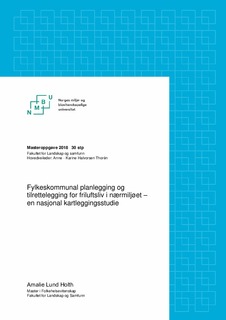| dc.contributor.advisor | Thoren, Anne-Karine Halvorsen | |
| dc.contributor.advisor | Nordh, Helena | |
| dc.contributor.author | Holth, Amalie Lund | |
| dc.coverage.spatial | Norway | nb_NO |
| dc.date.accessioned | 2018-07-17T11:50:31Z | |
| dc.date.available | 2018-07-17T11:50:31Z | |
| dc.date.issued | 2018 | |
| dc.identifier.uri | http://hdl.handle.net/11250/2505837 | |
| dc.description.abstract | Bakgrunn: Forskning peker på at kun et fåtall av Nordmenn innfrir anbefalingene om 150 minutter moderat fysisk aktivitet i uka, eller 75 minutter hard fysisk aktivitet. Friluftsliv i form av turgåing ser ut til å være en aktivitet som appellerer til store deler av befolkningen. Aktiviteten kan dermed være et viktig virkemiddel i folkehelsearbeidet. I dag er fylkeskommunen ansvarlig for de fleste oppgaver innen friluftsliv, og de kan dermed påvirke tilretteleggingen og planleggingen for turgåing i nærmiljøet (nærturer). Vi vet i liten grad hvordan de ulike fylkeskommunene i Norge arbeider overfor kommunene i dette arbeidet.
Formål: Formålet med studien er å belyse hvordan sentrale aktører på fylkeskommunalt nivå arbeider med fylkeskommunal planlegging og tilrettelegging som kan bidra til at flere får mulighet til å bruke nærmiljøet der de bor til turgåing. Det har vært ønskelig å peke på eventuelle forbedringer som kan gjøres i dette arbeidet.
Metode: En kvantitativ metode i form av en spørreundersøkelse er valgt for å besvare problemstillingen.
Hovedfunn: Det er få fylkeskommuner som har forankret nærturarbeidet i den regionale planstrategien. Mange har derimot folkehelseplaner og planer for fysisk aktivitet, idrett og/ eller friluftsliv e.l. (FIF – planer) som omhandler nærtur. I FIF - planen er nærtur satt på agendaen gjennom målsettinger og oppfordringer om hva kommunene bør prioritere. I arbeidet med planen er mange fylkeskommunale etater involvert. Etat for samferdsel ser ikke ut til å være en av disse. Det er et generelt funn at råd og organisasjoner involveres som høringsinstans i arbeidet med planen, herunder skiller grunneierlagene seg ut som lite involvert. I kommunal planlegging bidrar mange fylkeskommuner med rådgivning av betydning for nærtur. Mange fylkeskommuner arrangerer også fagseminarer overfor kommunene med fokus på behovet for nærturtiltak. Kommunepolitikerne inviteres sjeldent til disse. De folkehelseansvarlige identifiseres som viktige aktører for nærturarbeidet både innad i fylkeskommunen og i informasjonsarbeidet overfor kommunene. Mange fylkeskommunale tilskuddsordninger innenfor friluftsliv kan fremme turgåing i nærmiljøet, herunder blir nærtur prioritert i fordelingen av tilskudd. | nb_NO |
| dc.description.abstract | Background: Research points out that few Norwegians reaches the recommended level of 150 minutes of moderate physical activity a week, or 75 minutes of vigorous intensity activity. Outdoor recreation (Friluftsliv), in form of walking seems to be an activity that appeals to large sections of the population. This form of activity can therefore be important in public health work. Today, the county municipality is responsible for many of the tasks within Friluftsliv, and they may therefore affect people’s opportunity to walk in their neighborhood (nærturer) through planning and organizing. We know little about how the county municipalities in Norway work towards the municipalities in this work.
Objective: The purpose of the study is to illustrate how key actors at the county council level work with planning and organizing that can promote people’s opportunity to walk in their neighborhood. It has been desirable to point out improvements that can be made in this work.
Method: A quantitative method in form of a survey has been chosen to answer the issue.
Main findings: Only a few county municipalities have included nærtur in the county municipal plan strategy. Many, however, have public health plans and plans for physical activity, sports and/or outdoor life (FIF- plans) including nærtur. In this plan nærtur is put on the agenda through objectives and solicitations to the municipalities. Many agencies within the county municipalities are involved in the FIF- plan. The agency for transportation does not seem to be one of these. It is a general finding that councils and organizations are involved as consultative bodies in the work of the plan. The landowners are little involved. In municipal planning, many county municipalities contribute counseling of importance to nærtur. Many also arrange seminars focusing on the need for nærtur, but the municipality politicians are rarely invited. Public health workers are important for nærtur both within the county municipality work and in the information work towards the municipalities. Many subsidies within friluftsliv can promote people’s opportunity to walk in their neighborhood, nærtur seems to be prioritized in the allocation of these subsidies. | nb_NO |
| dc.language.iso | nob | nb_NO |
| dc.publisher | Norwegian University of Life Sciences, Ås | nb_NO |
| dc.rights | Attribution-NonCommercial-NoDerivatives 4.0 Internasjonal | * |
| dc.rights.uri | http://creativecommons.org/licenses/by-nc-nd/4.0/deed.no | * |
| dc.subject | Regional planlegging | nb_NO |
| dc.title | Fylkeskommunal planlegging og tilrettelegging for friluftsliv i nærmiljøet : en nasjonal kartleggingsstudie | nb_NO |
| dc.type | Master thesis | nb_NO |
| dc.subject.nsi | Folkehelsevitenskap | nb_NO |
| dc.source.pagenumber | 129 | nb_NO |
| dc.description.localcode | M-FOL | nb_NO |

